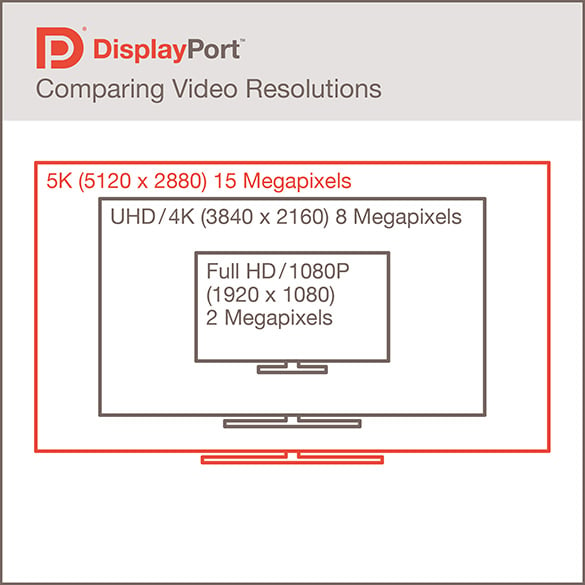VESA Announces DisplayPort 1.3 With Higher Bandwidth, 5K Monitor Support
Many companies haven't even introduced 4K displays with their own logo on them yet, and we're already looking ahead to what's next. That's typical for the tech space, but 5K displays seem closer than most would have guessed. The Video Electronics Standards Association (VESA) has just announced the DisplayPort 1.3 audio/video standard, which is a meaningful update to the DisplayPort 1.2a standard. The new protocol increases the maximum link bandwidth to 32.4 Gbps, with each of four lanes running at a link rate of 8.1 Gbps/lane—a 50% increase from the previous version of the DisplayPort standard. Allowing for transport overhead, DisplayPort’s 32.4 Gbps combined link rate delivers 25.92 Gbps of uncompressed video data.


Now, all that's left is for member companies to start producing connectors and compatible displays, which we suspect will populate the floor at CES in January. Hopefully your 4K equipment won't be too jealous.

The increased bandwidth enables higher resolution monitors, including recently announced 5K monitors (with pixel resolutions of 5120 x 2880) using a single DisplayPort cable, without the use of compression. It will also enable higher resolutions when driving multiple monitors through a single connection using DisplayPort’s Multi-Stream feature, such as the use of two 4K UHD monitors, each with a pixel resolution of 3840 x 2160, when using VESA Coordinated Video Timing.
DisplayPort 1.3 continues to support video conversion to VGA, DVI and HDMI. DisplayPort 1.3 adds support for HDCP 2.2 and HDMI 2.0 with CEC (Consumer Electronics Control), which enhances DisplayPort’s utility for television applications, including 4K video with copy protection. The new standard adds support for the 4:2:0 pixel structure, a video format commonly used on consumer digital television interfaces, which enables support for future 8K x 4K displays.
DisplayPort 1.3 also enhances DisplayPort’s value for multi-function interfaces that combine data transport, A/V transport and other capabilities on a single cable. It further refines protocols that enable DisplayPort to share a single cable with other data types. With its higher 8.1 Gbps per-lane link rate, DisplayPort 1.3 can support a single UHD monitor with 60Hz refresh and 24-bit color over two lanes, while assigning the remaining two lanes to increase capacity for alternate data types, such as SuperSpeed USB data as allowed in DockPort. DisplayPort is the A/V transport standard used by DockPort, Thunderbolt and other wired and wireless multi-function interface standards.

Now, all that's left is for member companies to start producing connectors and compatible displays, which we suspect will populate the floor at CES in January. Hopefully your 4K equipment won't be too jealous.

